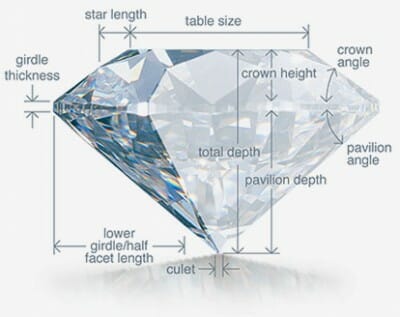
EDUCATION
Learn how to carefully evaluate the certificate, cut, colour, clarity and carat before purchasing your perfect diamond. These are known as the 5Cs of diamond grading.

Certificate
 It all starts with the Certificate…
It all starts with the Certificate…
A diamond certificate is the primary tool which enables you to separate the great diamonds from the rest before confirming its visual beauty.
Show MoreCut
The cut of a diamond refers not to its shape, but to the balance of proportion, symmetry and polish achieved by the diamond cutter. The extent of how well the diamond is cut is directly related to the diamond’s overall beauty. When a diamond has been correctly cut, the diamond’s ability to reflect and refract light is greatly enhanced. Cut is considered to be the most important of all of the diamond characteristics.
Show MoreColour
Colour refers to the natural body colour of a diamond, and not to the reflection of spectral colours that flash when a diamond moves. Most diamonds naturally exhibit slight hints of yellow, brown or gray. This colour is caused by natural trace elements of nitrogen that were present when the diamond formed under the Earth’s crust. The less colour a diamond exhibits, the higher the rarity, and therefore the higher the value.
Show MoreClarity
 Since diamonds are formed deep within the earth, under extreme heat and pressure, they often contain unique birthmarks, either internal (inclusions) or external (blemishes). Diamond clarity refers to the absence of these inclusions and blemishes. Diamonds without these birthmarks are rare, and rarity affects a diamond’s value. Expert graders assign diamonds a clarity grade that ranges from flawless (FL) to diamonds with obvious inclusions (I3).
Since diamonds are formed deep within the earth, under extreme heat and pressure, they often contain unique birthmarks, either internal (inclusions) or external (blemishes). Diamond clarity refers to the absence of these inclusions and blemishes. Diamonds without these birthmarks are rare, and rarity affects a diamond’s value. Expert graders assign diamonds a clarity grade that ranges from flawless (FL) to diamonds with obvious inclusions (I3).
Carat
This is the diamond’s physical weight measured in metric carats. 1 carat equals 0.2 grams and is subdivided into 100 points, just as a dollar is divided into 100 pennies. Carat weight is the most objective of the diamond’s 5Cs. It involves no estimates, comparisons, or judgments. All that is required is a precisely balanced scale capable of weighing extremely small weights. Yet, despite the ease of measurement and the relative unimportance of diamond weight, there are some facts you should understand about weight and price.
Show More

